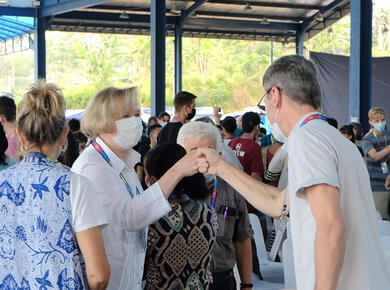Posted: April 18, 2023
As the war in Ukraine continues into a second year, Anabaptists along with other Christians continue to pray and work for peace. During the season of Lent, churches around the world gathered online together for a second ecumenical prayer service to lament the war in Ukraine and other locations of conflict. Church leaders including MWC general secretary César García offered prayers and reflections.
In the Swiss Mennonite news bulletin, editor Simon Rindlisbacher asked MWC general secretary César García about pacifism. Reprinted with permission from Konferenz der Mennoniten Der Schweiz/Conference Mennonite Suisse.
How strong of a concern is the war in Europe for churches in other countries that are part of MWC?
The war is a topic of concern in many places. After all, it also has global implications. People worry about the threat of nuclear war and are affected by the inflation the war has caused.
In countries in Africa or South America, this has become an additional burden along with the pandemic.
I also talked to people who said: the war is terrible, of course, but it is not the only one in the world. Other, similarly terrible conflicts are not getting the same attention in Europe at the moment.
I’m thinking, for example, of the situation in Myanmar, Congo or Eritrea. But also Colombia or South America in general. Some of these countries have been involved in conflicts for years. The people and the churches there are suffering. I think it is important that we do not forget them because of the war in Ukraine.
Mennonites are sometimes accused of irresponsibility, even by other churches. In the face of a war, is it appropriate to continue to adhere to pacifism and nonviolence?
This question arises in any violent conflict, and it is easier to think about it when one is not directly involved. I think with pacifism, it’s important that we stay completely with ourselves. We cannot demand a pacifist attitude from others, but only from ourselves.
We can always ask ourselves: what do I do when I am under violent attack? Of course, the answer is difficult if I have never been in such a situation, and maybe I would react with violence. That is all too human. Nevertheless, I can hold on to the idea that for me, basically, the nonviolent way is the right way.
And this is what we should do?
As Christians, pacifism and a pacifist attitude is our vocation. From my point of view, something like a Christian war supporter is a contradiction in terms. But even if we are called to pacifism, ultimately, we cannot make a pacifist response on our own. If we want to make peace, as Jesus did, we depend on the support of an ecclesial community and the power of the Holy Spirit.
When peace occurs, it is always a miracle. We can allow God to work through us and help us respond like Jesus did nonviolently.
From your perspective, how should we as Mennonites and peace churches in Europe respond to the war in Ukraine?
There is no universal answer to this. Every conflict is different and takes place in a different context each time. But one thing churches can always do when confronted with violence is to develop creative ways to confront it in a collaborative process.
Pacifism does not mean being a bystander. Being a pacifist means resisting and doing something about violence. There are many examples in history that nonviolent resistance works.
Which ones do you think of?
Remember Martin Luther King Jr., or the priest André Trocmé who with his congregation hid Jews from Nazi persecution. These people found nonviolent, creative and effective ways to resist violence.
Sometimes I wonder: what would have happened if the people in Ukraine had decided not to resist with force of arms? If they had said, “Here, take our land without bloodshed,” but then stood up to the occupying power with civil disobedience? Would that have been worse than what the people of Ukraine are going through now? All the deaths, the destruction? I don’t know.
Force of arms and war is always an easy answer. Nonviolence is much more complicated and requires a lot of creativity. But it is possible.
You come from Colombia, a country where armed conflict is sadly an everyday reality. What can we learn from the Mennonites in Colombia?

First of all, it is important to understand that peace work is the work of generations. You can get involved as a single person, but you may not experience the fruits of your efforts.
Colombia has experienced a lot of violence in the last 250 years. Mennonite churches started peace work 70 years ago and it is still going on today. Our attitude is: we are not pacifists because of what our commitment brings about, but because it is our calling as Christians; because of what God is doing in us and through us and driven by the Christian hope that a world of peace is possible.
What does your peace work look like in concrete terms?
It is very multifaceted. Basically, the goal is to promote a culture of peace in Colombia and to establish a pacifist lifestyle. To this end, some Mennonite churches work with schools, for example, showing them how to teach children to resolve conflicts in a peaceful and healthy way.
Other churches train leaders in businesses. They show them how to deal with conflict in the workplace.
In Colombia, violence within families is also a big problem. Therefore, other Mennonite churches work with families and show them how to resolve conflicts without violence. In this way we bring ideas of how to make peace into people’s daily lives.
Are you involved at the political level?
Yes. For example, we are campaigning for people not to have to do military service. We have made proposals to the government about what a civilian alternative service could look like.
We have also participated in demonstrations against the use of force, proposals and laws that stand in the way of peace.
And there are also churches that have refused to pay taxes that would finance violent measures by the government.
Do you also directly approach the armed factions, such as the illegal armies or the drug gangs?
We have done that, even though it is very risky. Several times, leaders of Mennonite congregations have tried to talk to the armed parties about their differences. The goal in each case has been to show them ways to resolve their conflicts peacefully.
Peace activists have already lost their lives in the process. Because as soon as you talk to one party to a conflict, you may be seen as an enemy by the other. But we have also had very good experiences and have guided the conflicting parties to a more peaceful way of life.
By the way, it’s also important that we don’t just focus on preventing violence, but also take care of the victims of violence.
What do you do for the victims?
For the victims of violence, we offer counselling and programs for healing from trauma. For example, if they have lost loved ones or lost their possessions. We support people who are fleeing violence. We are talking about several thousand. We help them to leave the country if that is the best solution. And if they can stay, we support them with money, housing, jobs and much more.
This work also contributes to a culture of peace in the long run.
Of all these examples, what do you think is most likely to be implemented in Europe?
In daily life, too, we need the ability to deal with conflicts in a healthy and peaceful way.
In my opinion, it is one of the tasks of the churches to practice this and thus train nonviolence as a lifestyle. If you succeed in this, you are more likely to know how to react creatively and nonviolently to war. If you only think about possibilities for peaceful conflict resolution when wars break out, it is much more difficult to see such possibilities.
—This article reprinted with permission from Swiss Mennonite news bulletin

Join the Conversation on Social Media
FacebookTwitterInstagramFlickrYouTube